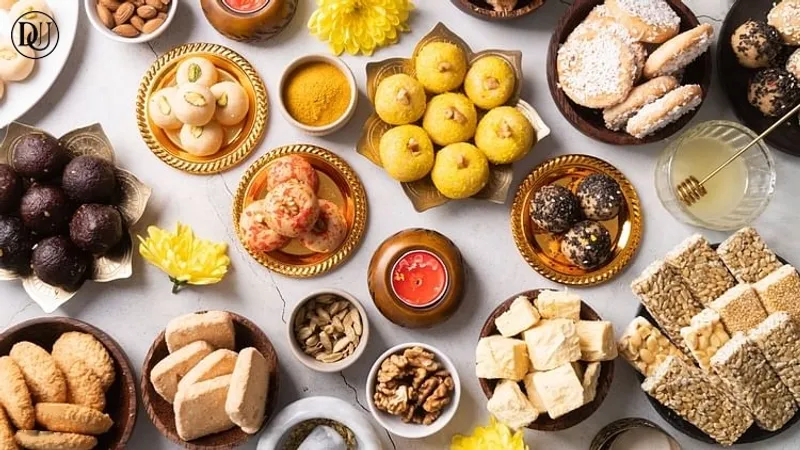Does anything really capture the essence of an Indian festival quite like its food? I was just sitting here, 2 AM, mind wandering, and it hit me—the sheer, comforting weight of traditional Raksha Bandhan recipes. It’s more than just a meal, you know, it’s like a tangible connection to family history, to all those celebrations gone by. You tie the rakhi, you exchange gifts, sure, but the real heart of it often beats loudest in the kitchen, churning out those specific sweets and snacks.
The Sweet Heart of Raksha Bandhan 💖
Honestly, you can't even say "Raksha Bandhan" without your mind immediately picturing a plate piled high with mithai. It's just inherently linked, isn't it? Like, for Teej, you think Ghevar, right? That crisp, honeycomb-like disc drenched in syrup, maybe topped with malai. It's listed as a Hariyali Teej staple, but honestly, it makes an appearance for Rakhi too in many homes, especially up north. There's this undeniable craving for something sugary, something rich, to mark the occasion. And it's not just about satisfying a sweet tooth; it's about the ritual, the shared joy of indulgence.
Mithai Classics You Can't Miss 🍬
When we talk traditional, obviously the usual suspects come to mind. Laddoo, for one. Besan laddoo, motichoor laddoo—those little golden spheres just scream festivity. And then there's Barfi, in all its myriad forms. Kaju Katli, milk barfi, pista barfi… the list goes on. Each one, a tiny bite of tradition, often homemade with so much love and effort. I mean, making barfi properly, getting that perfect melt-in-your-mouth texture without it being too crumbly or too chewy? That's an art form, frankly. Some families even have their secret ingredient or technique, passed down generations. It’s not about the fancy gourmet stuff you see now, like artisanal chocolates and whatnot, which, don’t get me wrong, are delicious for Rakhi too, as Slurrp mentioned, but they don't carry the same weight of tradition, do they?
Beyond Laddoo: Regional Delights 🗺️
It’s fascinating how different regions have their own special contributions to the Rakhi feast. Take Ghevar, for example, which I mentioned earlier from the Teej context – it's a huge deal in Rajasthan and parts of Uttar Pradesh. Or Petha from Agra, which also features on festive tables. In Bengal, you've got your Sandesh and Roshogolla, light yet incredibly flavorful. Down south, you might see Payasam or different kinds of Halwa—like Moong Dal Halwa or Gajar Halwa—being prepared. It’s not just one standard menu across the whole country. Each family, each region, adds its own unique culinary fingerprint, making the celebration truly diverse and vibrant. It’s a beautiful reflection of India’s culinary tapestry, really.
Savory Bites: The Unsung Heroes 🥨
While sweets definitely dominate the conversation, let’s not forget the savory snacks, the unsung heroes of any Indian festive spread. Because after all that sweetness, you just *need* something salty, right? Mathri, for instance, those crispy, flaky fried discs often flavored with carom seeds—perfect with a cup of chai. Or Namak Pare, those diamond-shaped savory biscuits. In some homes, you’ll find Dahi Bhalla, soft lentil fritters soaked in yogurt and topped with chutneys, or even a proper Aloo Chaat. These snacks basically balance out the intense sweetness and provide a much-needed textural contrast. They’re usually much easier to whip up in bigger batches too, which is a plus when you’re feeding a whole family.
Homemade vs. Store-Bought: A Timeless Debate 🤔
This is probably the biggest internal debate for anyone preparing for a festival. Do you spend hours in the kitchen, meticulously making everything from scratch, or do you just hit up the local mithai shop? Honestly, there’s no right answer. Homemade certainly carries that unique touch of love and effort—and you know exactly what’s in it, which is a huge comfort. My grandmother, she always believed homemade was the only way, and I've noticed that sentiment carries a lot of weight for many. But let's be real, life gets busy. Sometimes, those trusted sweet shops, especially the really old, famous ones, just nail it. Their quality is consistent, and they save you a ton of time. It really just boils down to what feels right for the family, or how much time you actually have. Both options have their merits, you know?
The Evolution of Festive Feasts ✨
Festivals evolve, and so does the food, somewhat. While traditional recipes remain the bedrock, you do see modern interpretations creeping in. Like those artisanal chocolates for Rakhi that are becoming popular, or fusion desserts. Is that really surprising? Not at all. Tastes change, ingredients become more accessible, and people get adventurous. But here’s the thing: no matter how many gourmet cupcakes or exotic cheesecakes show up on the table, the core, the essence, still comes back to those traditional laddoos, that barfi, that homemade mathri. They’re the anchors, the taste of nostalgia. It’s like a respectful nod to the past, while still embracing the present. Raksha Bandhan's culinary traditions are basically a living, breathing history, adapting but never truly forgetting their roots. It’s quite beautiful, actually.










